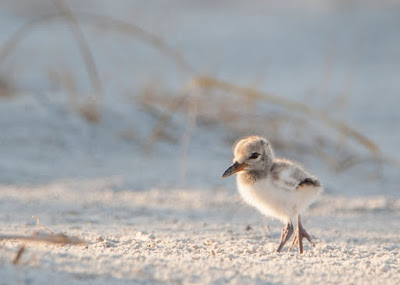We have not seen the American Oystercatcher chick on the beach or being fed by parents for over 48 hours. The parents have been seen on the beach alone and we are uncertain about what happened to the chick. According to the American Oystercatcher Working Group, most chick mortality takes place in the first two weeks of life and generally just prior to fledging (flying). The most frequent causes of death for chicks in North Carolina include exposure, mammalian and avian predation, ghost crabs and human disturbance.
We are pleased to have been able to share our first chick in three years with many beach goers and we're disappointed in this result.
But we remain optimistic about this challenging nesting season and look forward to Black Skimmer and Common Tern chicks soon.
One of our WB Bird Stewards, Bonnie-Jeanne Berg, not only expressed what many of us are feeling but took some (now cherished) photos of the chick.
" I referred the chick to my Saturday morning beach-goers as our "Golden Child".... and what a show we had from the family... hope you enjoy .... and I am looking forward to our next babies... the show must go on.... and how thankful we will be!"
 |
| look closely to see the chick's legs under the mom photo by Bonnie-Jeanne Berg |
 |
| photo by Bonnie-Jeanne Berg |
 |
| photo by Bonnie-Jeanne Berg |
 |
| photo by Bonnie-Jeanne Berg |
 |
| photo by Bonnie-Jeanne Berg |
 |
| photo by Bonnie-Jeanne Berg |
 |
| photo by Bonnie-Jeanne Berg |
 |
| photo by Bonnie-Jeanne Berg |
 |
| photo by Bonnie-Jeanne Berg |

Oyster Catchers are amazing looking birds. The size of their beak compared to their bodies is incredible. These are some great captured moments in time, thanks for the share. Hope you had a wonderful weekend.
ReplyDeleteWorld of Animals